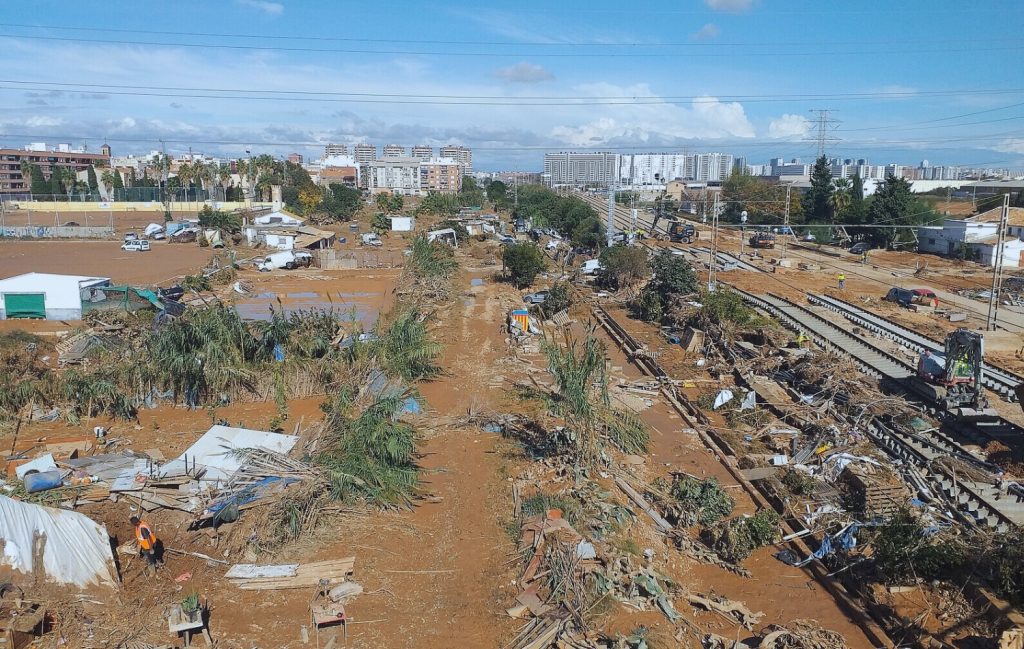Listen to the article
Social Media Platforms Accused of Amplifying Flood Disinformation in Spain’s Worst Natural Disaster
YouTube and TikTok have come under fire for spreading false information that “sowed confusion” during Spain’s deadliest flood in decades, according to a damning new report by Spanish fact-checking service Maldita.es and digital investigations agency AI Forensics.
The catastrophic flooding that struck Valencia in October 2024 claimed 237 lives after a year’s worth of rain fell in just eight hours, making it Europe’s most devastating flood since 1967. In the aftermath, disinformation about the disaster reached over 21 million views across YouTube and TikTok, creating significant challenges for emergency responders.
Researchers found that false content not only “caused panic” but also “undermined or even explicitly denied” the scientifically established link between climate change and the disaster’s severity. Climate scientists have attributed the extreme flooding to a weather phenomenon known as ‘DANA’ (isolated low-pressure system at upper levels), which was intensified by Mediterranean Sea temperatures that were 5°C above normal.
The report highlights how platform algorithms systematically promoted misleading content. On YouTube, false videos received 48 percent more likes and 123 percent more comments than accurate information. These misleading videos garnered four times more views than the average YouTube content, accumulating 13 million views in total.
TikTok showed similar patterns, with disinformation 85 percent more likely to be shared than accurate content. False videos on the platform were viewed over 8.3 million times in the month following the disaster.
“YouTube and TikTok’s recommendation algorithms are designed to amplify content to maximise user engagement and as a result, are known to recommend content that provokes strong user reactions,” the report stated. “In this case, that content was dis/misinformation, which our findings suggest received amplification above and beyond more factual information.”
The investigation also revealed significant failures in content moderation. Despite TikTok’s policy prohibiting “misinformation that denies the existence of climate change, misrepresents its causes, or contradicts its established environmental impact,” researchers identified more than 100 videos downplaying or denying climate change’s role in the flooding. Many of these videos remain on the platform a full year after the disaster without warning labels.
YouTube’s performance was marginally better but still problematic. While the platform commits to “provide users with tools to help them make more informed decisions,” less than 25 percent of videos containing flood disinformation received any form of warning label.
Carlos Hernández-Echevarría, associate director at Fundación Maldita.es, explained the underlying issue: “Climate dis/misinformation thrives on social media platforms, fuelled by systems that want to maximise screen time, engagement, and advertising revenue.”
The findings raise serious questions about the responsibility of tech platforms during natural disasters, particularly as climate change increases the frequency and severity of extreme weather events worldwide. Spain’s Valencia flooding serves as a case study in how algorithmic amplification can undermine public safety and climate science communication during emergencies.
Salvatore Romano, head of research and co-founder at AI Forensics, expressed frustration at the ongoing challenge: “One year after the DANA, we’re still debunking the same tired climate myths. Despite the rapid increase in the frequency and intensity of extreme weather events, which puts a growing number of lives at risk, the response from platforms continues to fall short.”
The investigation comes amid growing global concerns about the role of social media in spreading climate misinformation. As extreme weather events become more common due to climate change, the ability of platforms to responsibly handle disaster-related information becomes increasingly critical for public safety and coordinated emergency response.
Neither YouTube nor TikTok has issued an official response to the findings at the time of publication.
Fact Checker
Verify the accuracy of this article using The Disinformation Commission analysis and real-time sources.




10 Comments
This is a troubling example of how disinformation can take root and spread rapidly online, especially during a crisis. Social media companies must strengthen their content moderation and fact-checking capabilities to prevent the amplification of false claims that can endanger public safety.
Agreed. Responsible platform policies and greater transparency around content moderation practices are essential to combat the rise of dangerous misinformation, especially around natural disasters and climate change.
The report raises serious concerns about the role of social media in spreading misinformation during this devastating flood. Platforms need to take more accountability for the content they amplify, especially when it undermines emergency efforts and climate science.
While social media can be a valuable tool for communication and awareness during emergencies, the proliferation of disinformation is clearly a major issue that needs to be addressed. Platforms must do more to verify claims and limit the spread of false narratives.
Absolutely. Disinformation can hinder emergency response and undermine public understanding of the science behind these events. Responsible platform policies are critical.
The scale of disinformation around this flood disaster is alarming. It’s critical that social media companies take stronger action to curb the spread of misleading claims, especially those that deny the role of climate change. Responsible reporting is essential in times of crisis.
You make a good point. Downplaying the climate change factor is especially problematic and can undermine public understanding of these extreme weather events.
This is a concerning report. Social media platforms need to do more to combat the spread of disinformation, especially around major disasters. Amplifying false claims can undermine emergency response efforts and public understanding of the science behind extreme weather events.
Agreed. Platforms should prioritize authoritative sources and fact-checking over sensationalized or unsubstantiated content. Disinformation can be dangerous in crisis situations.
This is a sobering example of how social media can amplify misinformation during natural disasters. The report highlights the need for better content moderation and fact-checking to protect public safety and trust in authoritative sources.